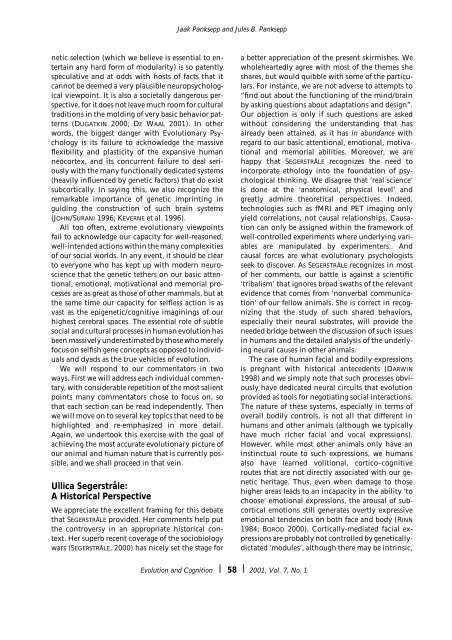The Seven Sins of Evolutionary Psychology - Konrad Lorenz Institute
The Seven Sins of Evolutionary Psychology - Konrad Lorenz Institute
The Seven Sins of Evolutionary Psychology - Konrad Lorenz Institute
Create successful ePaper yourself
Turn your PDF publications into a flip-book with our unique Google optimized e-Paper software.
Jaak Panksepp and Jules B. Pankseppnetic selection (which we believe is essential to entertainany hard form <strong>of</strong> modularity) is so patentlyspeculative and at odds with hosts <strong>of</strong> facts that itcannot be deemed a very plausible neuropsychologicalviewpoint. It is also a societally dangerous perspective,for it does not leave much room for culturaltraditions in the molding <strong>of</strong> very basic behavior patterns(DUGATKIN 2000; DE WAAL 2001). In otherwords, the biggest danger with <strong>Evolutionary</strong> <strong>Psychology</strong>is its failure to acknowledge the massiveflexibility and plasticity <strong>of</strong> the expansive humanneocortex, and its concurrent failure to deal seriouslywith the many functionally dedicated systems(heavily influenced by genetic factors) that do existsubcortically. In saying this, we also recognize theremarkable importance <strong>of</strong> genetic imprinting inguiding the construction <strong>of</strong> such brain systems(JOHN/SURANI 1996; KEVERNE et al. 1996).All too <strong>of</strong>ten, extreme evolutionary viewpointsfail to acknowledge our capacity for well-reasoned,well-intended actions within the many complexities<strong>of</strong> our social worlds. In any event, it should be clearto everyone who has kept up with modern neurosciencethat the genetic tethers on our basic attentional,emotional, motivational and memorial processesare as great as those <strong>of</strong> other mammals, but atthe same time our capacity for selfless action is asvast as the epigenetic/cognitive imaginings <strong>of</strong> ourhighest cerebral spaces. <strong>The</strong> essential role <strong>of</strong> subtlesocial and cultural processes in human evolution hasbeen massively underestimated by those who merelyfocus on selfish gene concepts as opposed to individualsand dyads as the true vehicles <strong>of</strong> evolution.We will respond to our commentators in twoways. First we will address each individual commentary,with considerable repetition <strong>of</strong> the most salientpoints many commentators chose to focus on, sothat each section can be read independently. <strong>The</strong>nwe will move on to several key topics that need to behighlighted and re-emphasized in more detail.Again, we undertook this exercise with the goal <strong>of</strong>achieving the most accurate evolutionary picture <strong>of</strong>our animal and human nature that is currently possible,and we shall proceed in that vein.Ullica Segerstråle:A Historical PerspectiveWe appreciate the excellent framing for this debatethat SEGERSTRÅLE provided. Her comments help putthe controversy in an appropriate historical context.Her superb recent coverage <strong>of</strong> the sociobiologywars (SEGERSTRÅLE, 2000) has nicely set the stage fora better appreciation <strong>of</strong> the present skirmishes. Wewholeheartedly agree with most <strong>of</strong> the themes sheshares, but would quibble with some <strong>of</strong> the particulars.For instance, we are not adverse to attempts to“find out about the functioning <strong>of</strong> the mind/brainby asking questions about adaptations and design”.Our objection is only if such questions are askedwithout considering the understanding that hasalready been attained, as it has in abundance withregard to our basic attentional, emotional, motivationaland memorial abilities. Moreover, we arehappy that SEGERSTRÅLE recognizes the need toincorporate ethology into the foundation <strong>of</strong> psychologicalthinking. We disagree that ‘real science’is done at the ‘anatomical, physical level’ andgreatly admire theoretical perspectives. Indeed,technologies such as fMRI and PET imaging onlyyield correlations, not causal relationships. Causationcan only be assigned within the framework <strong>of</strong>well-controlled experiments where underlying variablesare manipulated by experimenters.. Andcausal forces are what evolutionary psychologistsseek to discover. As SEGERSTRÅLE recognizes in most<strong>of</strong> her comments, our battle is against a scientific‘tribalism’ that ignores broad swaths <strong>of</strong> the relevantevidence that comes from ‘nonverbal communication’<strong>of</strong> our fellow animals. She is correct in recognizingthat the study <strong>of</strong> such shared behaviors,especially their neural substrates, will provide theneeded bridge between the discussion <strong>of</strong> such issuesin humans and the detailed analysis <strong>of</strong> the underlyingneural causes in other animals.<strong>The</strong> case <strong>of</strong> human facial and bodily expressionsis pregnant with historical antecedents (DARWIN1998) and we simply note that such processes obviouslyhave dedicated neural circuits that evolutionprovided as tools for negotiating social interactions.<strong>The</strong> nature <strong>of</strong> these systems, especially in terms <strong>of</strong>overall bodily controls, is not all that different inhumans and other animals (although we typicallyhave much richer facial and vocal expressions).However, while most other animals only have aninstinctual route to such expressions, we humansalso have learned volitional, cortico–cognitiveroutes that are not directly associated with our geneticheritage. Thus, even when damage to thosehigher areas leads to an incapacity in the ability ‘tochoose’ emotional expressions, the arousal <strong>of</strong> subcorticalemotions still generates overtly expressiveemotional tendencies on both face and body (RINN1984; BOROD 2000). Cortically-mediated facial expressionsare probably not controlled by geneticallydictated‘modules’, although there may be intrinsic,Evolution and Cognition ❘ 58 ❘ 2001, Vol. 7, No. 1








